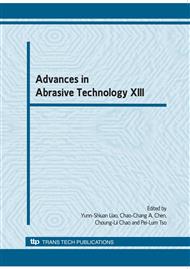p.9
p.17
p.23
p.29
p.35
p.41
p.47
p.52
p.58
Analysis and Modeling of Micro Abrasive Air Jet Cutting Aspect Ratio
Abstract:
Micro abrasive air jet machining technology is being increasingly used in the fields of micro cutting. Since the aspect ratio is a major interest characteristics of kerf in micro cutting, an experimental investigation is carried out to study the effect of cutting process parameters on the aspect ratio in this study. It is found that the aspect ratio increases with an increase in air pressure, abrasive flow rate and jet incidence angle, while decreases with an increase in nozzle traverse speed. Furthermore a predictive model for aspect ratio is developed using the dimensional analysis technique. It is shown that the model predictions are in good agreement with the experimental results. The research results may be meaningful to efficiently control the aspect ratio.
Info:
Periodical:
Pages:
35-40
Citation:
Online since:
August 2010
Authors:
Keywords:
Price:
Сopyright:
© 2010 Trans Tech Publications Ltd. All Rights Reserved
Share:
Citation:


